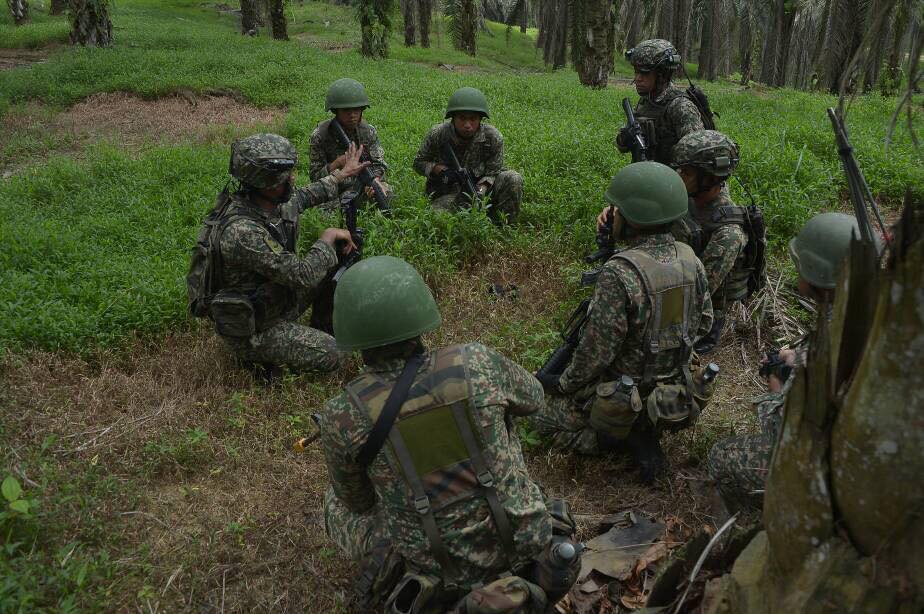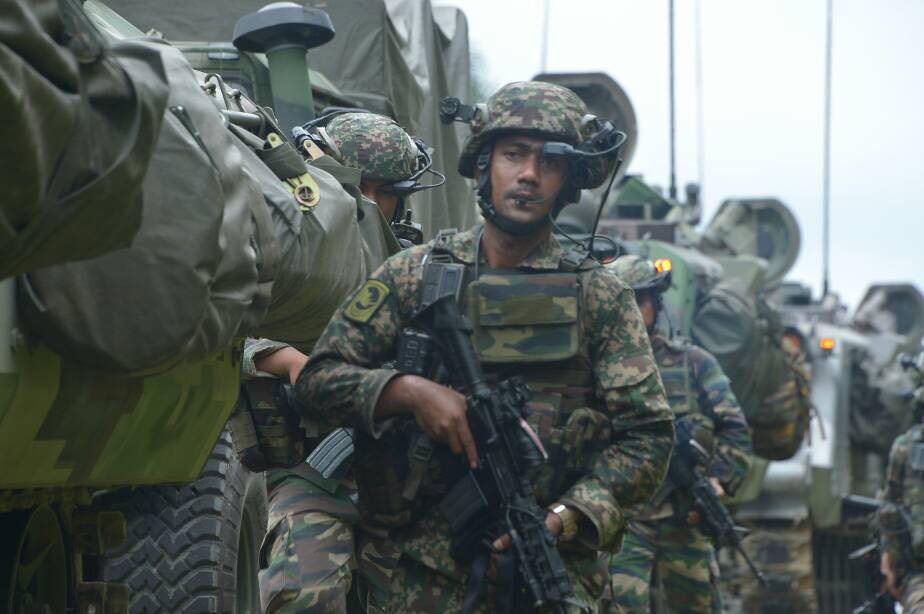SHAH ALAM: THE Army, specifically the Future Soldier System experimental platoon of the 12th Royal Malay Regiment (Mechanised) has conducted a training exercise synchronised with the Network Centric Operation (NCO) system.
The exercise is being conducted around Dungun and Kuantan, the favourite stomping ground of the 4th Mechanised Brigade, 12 RMR’s parent unit. Around 70 soldiers and officers are involved in the exercise.


Based on the Army’s Facebook post on the exercise, this was likely the first FSS Experimental Platoon exercise with the NCO. Indeed the Army dubbed the exercise as Network Centric Operation (NCO) Army Exercise 2017.


The NCO system was officialy inaugurated last year. Quoted below are parts of the post.
NCO Phase 1A became operational in Dec 2015 with the implementation of the X-Band satellite communication link. Under the NCO, the three services of the Armed Forces shared situational awareness and common operating picture using satelitte-based data link. It was hoped under the NCO, the three services will achieve self-synchronisation in operations.
At the moment, most of the NCO capability are mostly with the RMAF and RMN although some of the Army’s legacy system have also been integrated with the same system.
Among the legacy systems which had been NCO-enabled are the Army’s Grup Pertahanan Artileri Udara TRML-3D radar, Battery Control Post, Igla Vehicle Mounted Manpads, the Future Soldier System experimental platoon and ACV 300 command and control vehicle and the Land Rover Fixed for Radio.
The FSS experimental platoon was likely supported by the ACV300 Command and Control Vehicle which was fitted with the NCO system and with other NCO vehicles.
From the pictures, it is likely that exercise concentrated on getting the FSS Experimental Platoon to spear head the other units not equipped with the NCO system. The Army FSS program is meant to equip its infantry units with high tech gear backed by a networked array of communication and navigation equipment,
— Malaysian Defence
If you like this post, buy me an espresso. Paypal Payment
View Comments (13)
Has anyone bothered to carry out a study on the suitability of X-band satcoms in the Malaysian environment? If you think Astro reception is bad when it rains, just try X-band. But then again, it's just taxpayers' money. Why bother?
@ Durant
X-band is a specific frequency reserved for military and govenment use. One of its features is high resiliance in rain situations.
did the X-band worked same like the Astro reception... or the Astro using another band... or same -band differen working tool...
@lusoh
A television signal and military communication channels are two different sources. I somehow doubt Astro and X-Band will use the same frequency, let alone the same satellite.
I agree with @...
The X-Band should be resilient against the weather la. Hahahahaha tak kan raining cannot communicate.
Astro is on Ku-band, pls bother to get the facts right before hitting the moral high ground (taxpayers money, study bla bla bla)
durant & lusoh,
If its not durable and resilience why did the ATM bother to go with X-band? Of course they did their research. Military comm system is different than the civilian communications.Please read more before coming here and spat something useless.
Why would they bother build up a high tech NCO system and only to becomes useless when rain comes down?
Whose satellite does the MAF use?
Reply
MEASAT. The Armed Forces wanted their own one, of course, there is no money for it. So they have to make do with what is available and locally-controlled.
did they leased it from Measat latest satellite...for how long... and which branch of army that operated the main node of x-band in paya jaras camp...
Reply
Its the Armed Forces not Army...no idea of how long is the contract
Actually they put the x-band module onto the measat satellite before launching it into space. Prior measat satellites (up till now there is like 1/2 dozen, some older ones have fallen from orbit) does not have x-band capability.
Showing the typical attitudes of some Malaysians at the moment - why not do some preliminary enquiries first before coming up with lots of nonsensical remarks like "anyone bothered to carry out study on suitability", "just taxpayer's money. Why bother". Even if you don't support the government, or critical of the ATM, at least have facts handy before throwing these sentences like they are facts.
X-band satellite communication has military and non-military uses. Most armed forces choose to use it due to stability in most weather conditions including rain, coverage, security (for example) over other channels eg Ku Band, VHF, UHF bands.
It's expensive to own a satellite just for the military, especially for a country like ours, when even Australia and New Zealand for example has chosen to join together with USA for their X-band military communications. The reason we didn't join in that group is because we would prefer to be in control of our communications, and to leave less chance of spying/interruption should we choose to use the same satellites for military communication as other countries. Hence the leased option chosen to go with MEASAT. Heck, even Japan leases the X-band from other satellite providers rather than have their own.
Please don't be lazy especially if you're going to post here as if you have the right to do so - a quick review of the articles posted by Marhalim will reveal this:
"He admitted that the satellite would be very expensive but the Armed Forces was hopeful that the government will allocate funds for the project. Due to the high cost of the satellite – US made Wideband Global Satellite (WGS) cost some US335 million alone (RM1.06 billion) excluding the launch cost- the programme is expected to be funded via a Private Finance Initiaive. A company or companies will built/order/launch the satellite on behalf of the Armed Forces, and in return the Government pays the companies an annual fee for using its services. This is the same arrangement used by Japan to procure two X-band satellites which cost some US$1.5 billion. Using the PFI method the government may end up paying around RM100 million or slightly to lease the bandwidth for 15 years instead of forking up to RM2 billion up-front to procure and launch the satellite, which was the reason Japan used the PFI route"
Bukan apa, janganlah nak kondem aja tanpa usul periksa, dan janganlah ingat ATM tu cikai dan tak guna langsung - memang, banyak yang boleh biperbetulkan dan dibaiki, tapi berpadanlah nak tegur. Ni pun kos untuk Fasa 1A dah masuk RM 2 biliion, Fasa 1B pun lebih kurang sama jugak harganya - tu pun nak kondem jugak ke?